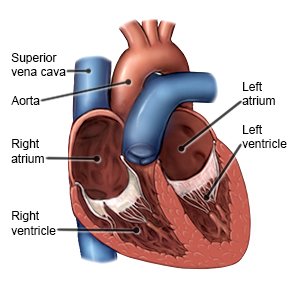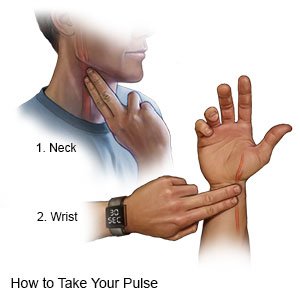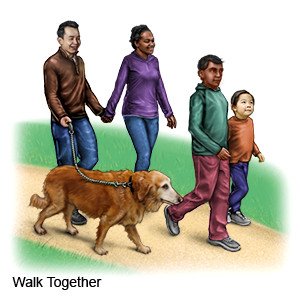Supraventricular Tachycardia
Medically reviewed by Drugs.com. Last updated on Aug 4, 2025.
AMBULATORY CARE:
Supraventricular tachycardia (SVT)
is a condition that causes your heart to beat much faster than it should. SVT is a type of abnormal heart rhythm, called an arrhythmia, that starts in the upper part of your heart. It may last from a few seconds or hours to several days.
 |
Common symptoms include the following:
- A pounding, racing, or fluttering heartbeat
- Fatigue, weakness, or shortness of breath
- Feeling lightheaded, dizzy, or faint.
- Pain, pressure, or tightness in your chest, neck, jaw, arms, or upper back
- Nausea
- Feeling anxious, scared, or worried that something bad may happen
Call your local emergency number (911 in the US) or have someone call if:
- You have any of the following signs of a heart attack:
- Squeezing, pressure, or pain in your chest
- You may also have any of the following:
- Discomfort or pain in your back, neck, jaw, stomach, or arm
- Shortness of breath
- Nausea or vomiting
- Lightheadedness or a sudden cold sweat
Seek care immediately if:
- You are dizzy, lightheaded, or feel faint.
- You have sudden numbness or weakness in your arms or legs.
Call your doctor or cardiologist if:
- You have new or worsening symptoms.
- You have swelling in your ankles or feet.
- You have questions or concerns about your condition or care.
Treatment
may depend on what is causing SVT and your symptoms. You may not need treatment for SVT. Instead you may need medicine or other procedures to control your heart rate.
Treatment options
The following list of medications are related to or used in the treatment of this condition.
Check your heart rate (pulse) as directed:
Your healthcare provider will show you how to check your pulse, and how often to check it. Write down how fast your pulse is and if it feels regular or like it is skipping beats. Also write down the activity you were doing if your heart rate is above 100. Bring the information with you to your follow-up appointment.
 |
How to manage or prevent SVT:
- Perform vagal maneuvers as directed when you have symptoms of SVT. Lie down flat and bear down like you are having a bowel movement. Do this for 10 to 30 seconds.
- Do not drink caffeine or alcohol. These can increase your risk for SVT.
- Keep a record of your symptoms. Write down what you ate or what you were doing before an episode of SVT. Also write down anything you did to make the SVT stop. Bring your record to follow up visits with your healthcare provider.
- Eat heart-healthy foods. These include fruits, vegetables, whole-grain breads, low-fat dairy products, beans, lean meats, and fish. Replace butter and margarine with heart-healthy oils such as olive oil and canola oil.

- Exercise regularly and maintain a healthy weight. Ask about the best exercise plan for you. Ask your healthcare provider what a healthy weight is for you. Ask him or her to help you create a safe weight loss plan if you are overweight.

- Do not smoke. Nicotine and other chemicals in cigarettes and cigars can cause heart and lung damage. Ask your healthcare provider for information if you currently smoke and need help to quit. E-cigarettes or smokeless tobacco still contain nicotine. Talk to your healthcare provider before you use these products.
- Manage other health conditions. Take medicine as directed and follow your treatment plan. Your healthcare provider may need to change a medicine you are taking if it is causing your SVT. Do not stop taking any medicine unless directed by your provider.
Follow up with your doctor or cardiologist as directed:
Write down your questions so you remember to ask them during your visits.
© Copyright Merative 2025 Information is for End User's use only and may not be sold, redistributed or otherwise used for commercial purposes.
The above information is an educational aid only. It is not intended as medical advice for individual conditions or treatments. Talk to your doctor, nurse or pharmacist before following any medical regimen to see if it is safe and effective for you.
Learn more about Supraventricular Tachycardia
Treatment options
Care guides
Symptoms and treatments
Further information
Always consult your healthcare provider to ensure the information displayed on this page applies to your personal circumstances.
